surgeon
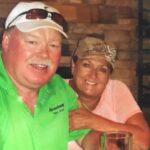
 They say that everyone remembers that moment when they are told that they have Cancer, and I’m sure that is true. For my sister, Alena Stevens, it all started in November of 2022. She had gone in for her annual screening and pap smear. Normally, the Gynecologist gave her the paperwork to go and set up her mammogram, which she had always filed in file 13. She hadn’t gone in for years, but by Divine Intervention, the doctor took it out of her hands and had Casper Imaging call her to get an appointment. So, reluctantly, she went in and had a mammogram. She was texted about two weeks later and told that she needed to come in for more images. Her first thought was, “Ok, no big deal.” She went in for the pictures, and they did several of them. They also wanted ultrasound pictures for a better look at four areas. Finally, they narrowed it down to one area in one breast and sent it to Dr Smothers, a surgeon.
They say that everyone remembers that moment when they are told that they have Cancer, and I’m sure that is true. For my sister, Alena Stevens, it all started in November of 2022. She had gone in for her annual screening and pap smear. Normally, the Gynecologist gave her the paperwork to go and set up her mammogram, which she had always filed in file 13. She hadn’t gone in for years, but by Divine Intervention, the doctor took it out of her hands and had Casper Imaging call her to get an appointment. So, reluctantly, she went in and had a mammogram. She was texted about two weeks later and told that she needed to come in for more images. Her first thought was, “Ok, no big deal.” She went in for the pictures, and they did several of them. They also wanted ultrasound pictures for a better look at four areas. Finally, they narrowed it down to one area in one breast and sent it to Dr Smothers, a surgeon.
The doctor was very upbeat and said it was no big deal because it was super small. He put Alena at ease immediately. He sent her back to Casper Medical Imaging for a biopsy. The initial determination was that the lump was not cancerous, but they had also sent it to Utah for a second opinion. It was determined to be cancer, but a very non-aggressive type. Again, Dr Smothers was very upbeat. He went in on January 23, 2023, and took it out. At that time, he did find a very small mass in one lymph node. That mass was the size of a grain of sugar, and he took it out too. The original lump in Alena’s breast was the size of a pepper corn or smaller. Alena was given 33 radiation treatments, done every day, five days a week for six weeks. The treatments were very successful, and Alena is now cancer free.


While Alena’s discovery and treatment story is amazing, it must be said that her support group was phenomenal. Her husband, Mike and kids, Michelle (Matt) Miller, Garrett (Kayla) Stevens, and Lacey Stevens (Chris Killinger) were all amazing!! Alena says, “Mike was a rock, as were the kids. I am so thankful for the support of my sisters, Cheryl Masterson, Caryn (Bob) Schulenberg, Caryl (Mike) Reed, and Allyn (Chris) Hadlock and their families; as well as Mike’s family, Scott (Barb) Stevens, Pat (Susie) Stevens, Annette (Hermis) Decoteau, Carrie (Mike) VonSenden, and Kathy (Mike) Huval and their families. Everyone was so great and checked with me often. But, above all, I give God the glory. We took communion every day and stood on the Word!”
Alena’s daughter, Michelle says, “Mom was a perfect example of faith, grace, and strength throughout this whole process. Obviously, we were very upset to hear about her diagnosis, but from the start she was positive and very strong about all of it. She led the way in moving through this process and she was a warrior. It was so touching to see how much it effected my dad, who is usually very stoic, as well. He was by her side and very supportive. And once she finished treatment, seeing how happy and proud of her, he was absolutely amazing. God is so good and the older we get, it’s amazing to see how much of an example our parents can still be to us. Also, the older we get the more thankful we are for our parents, so this process just made me even more thankful to have her. She is amazing and I feel like she is living her best life these days.”
Alena’s son Garrett says, “The only thing I have to add is that she wanted absolutely zero negativity from the beginning. She told everyone that this was already taken care of on the cross and that she didn’t want any 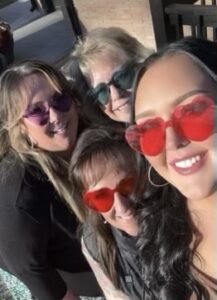
 negative thoughts about it. It was positive thoughts and planning only. I think she went through it all without any real fear and full of faith!!”
negative thoughts about it. It was positive thoughts and planning only. I think she went through it all without any real fear and full of faith!!”
Lacey told me just how proud she was of her dad, who was so supportive. She was proud to watch how positive her parents were. Their positive attitudes allowed their kids to stay positive about everything, and free from fear!! They just knew she would be ok, and they never worried about that. They all stood strong in faith, because of the leading of their parents.
Alena’s family all saw the same thing in her…a strong faith in God for her complete healing. And now, we are all rejoicing in her great victory. Above all else…to God be the glory!!
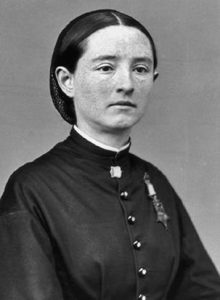 These days, we are all used to having a female doctor taking care of us. Those who haven’t are, nevertheless, not opposed to it. Others really don’t want a male doctor. It’s not a gender issue exactly, but there are women who just don’t feel comfortable with a male doctor, and men who don’t feel comfortable with a female doctor. We might have thought that this would not still be an issue all these years later, but it can be. As long as people are uncomfortable with their bodies, this might be the case.
These days, we are all used to having a female doctor taking care of us. Those who haven’t are, nevertheless, not opposed to it. Others really don’t want a male doctor. It’s not a gender issue exactly, but there are women who just don’t feel comfortable with a male doctor, and men who don’t feel comfortable with a female doctor. We might have thought that this would not still be an issue all these years later, but it can be. As long as people are uncomfortable with their bodies, this might be the case.
In the 1800s, however, this was not just an issue of discomfort, it was just not done. Mary E Walker was born in 1832, in Oswego Town near Oswego, New York. She was never one, to “hide her light,” but rather always stood out in a crowd. Even as a child, she was distinguished for her strength of mind and her decision of character. She grew into a very independent woman. Mary wanted to be useful. She had no desire to sit at home and be “just a housewife.” Mary was a feminist before most people knew what that was. She always had great energy, and in her early years, she wore bloomers, the pantaloon style garb of the radical feminists of the age. She decided to go to medical school, and when she graduated in 1855, she was the only female in her class from Syracuse Medical College. After graduation, she became one of the few women physicians in the country.
When the Civil War began in 1861, Dr Walker, who was 29 years old by then, journeyed to Washington DC and applied for an appointment as an Army surgeon. Of course, the Medical Department was…shocked, to put it mildly, and they quickly rejected her…with considerable verbosity. “A woman’s place is in the home,” or “No one will go to a woman doctor!” Dr Walker was not a woman who could be so easily discouraged. She stayed in Washington, and even served as an unpaid volunteer in various camps. Who would do that, and how did she survive without pay. Then, when the patent office was converted into a hospital, Walker served as assistant surgeon…again, without pay. During her time in the patent-office-turned-hospital, she was instrumental in establishing an organization that aided needy women who came to Washington to visit wounded relatives. It was a need that no one really thought about until she did, and it was probably reminiscent on the modern-day Ronald McDonald House.
As good as she was, Walker was not immune to considerable amounts of abuse over her persistent demands to be made a surgeon. Still, they could not dispute the fact that she also earned considerable respect for her many good works. It was about this time that she decided to abandon the bloomers and adopt a modified version of male attire, with a calf length skirt worn over trousers. She kept her hair relatively long and curled 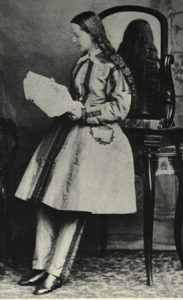 so that anyone could know she was a woman. While she wore a modified version of men’s clothes, she wanted everyone to know that she was a woman. She would not mask her talents by pretending to be a man.
so that anyone could know she was a woman. While she wore a modified version of men’s clothes, she wanted everyone to know that she was a woman. She would not mask her talents by pretending to be a man.
Finally, in November 1862, Dr Mary E Walker presented herself at the Virginia headquarters of MG Ambrose Burnside, and was taken on as a field surgeon. She was still a volunteer, but she was a titled surgeon. She treated the wounded at Warrenton and in Fredericksburg in December 1862. Almost a year later, she was in Chattanooga, Tennessee, tending the casualties of the battle of Chickamauga. After the battle, she again requested a commission as an Army doctor, such a simple thing after her years of loyal service, I would think. In September 1863, MG George H Thomas appointed her as an assistant surgeon in the Army of the Cumberland, assigning her to the 52nd Ohio Regiment. Finally, she had her commission. Now, many stories were told of her bravery under fire. Suddenly, it was ok to talk about just how incredible she was.
Sadly, she served with the 52nd Ohio Regiment for only a short time. In April 1864, Walker was captured by Confederate troops. She had stayed behind to tend wounded following a Union retirement. The Confederates charged her with being a spy and arrested her. The spy accusation came about as a result of her male attire. They said it constituted the principal evidence against her. Dr Walker spent the next four months in various prisons, being subjected to much abuse for her “unladylike” occupation and attire, until she was exchanged for a Confederate surgeon in August 1864.
In October of the same year, the Medical Department granted Dr Walker a contract as an acting assistant surgeon. Finally, 3 years after she first showed up on their doorstep she was given the rank and pay she deserved. Still, despite her requests for battlefield duty, she was not sent into the field again. She spent the rest of the war as superintendent at a Louisville, Kentucky, female prison hospital and a Clarksville, Tennessee orphanage. After she was released from her government contract at the end of the war, Walker lobbied for a brevet promotion to major for her services. Typically, Secretary of War Stanton would not grant the request. Finally, President Andrew Johnson asked for another way to recognize her service. A Medal of Honor was presented to Dr Walker in January 1866. She wore it every day for the rest of her life. She continued in the women’s rights movement and also crusaded against immorality, alcohol and tobacco, and for clothing and election reform. One of her more unusual positions was that there was no need for a women’s suffrage act, as women already had the vote as American citizens. Her taste in clothes never changed, and caused her frequent arrests on such charges as impersonating a man. At one trial, she asserted her right to, “Dress as I please in free America on whose tented fields I have served for four years in the cause of human freedom.” The judge  dismissed the case and ordered the police never to arrest Dr Walker on that charge again. She left the courtroom to hearty applause.
dismissed the case and ordered the police never to arrest Dr Walker on that charge again. She left the courtroom to hearty applause.
In 1916, Congress revised the Medal of Honor standards to include only actual combat with an enemy. Several months later, in 1917, the Board of Medal Awards, after reviewing the merits of the awardees of the Civil War awards, ruled Dr Walker’s medal, as well as those of 910 other recipients, as unwarranted and revoked them. It was an insult of the highest degree, and even after her death on February 21, 1919 at the age of 86, it was not to be forgotten. Nearly 60 years after her death, one of her descendants urged the Army Board for Correction of Military Records to review the case. On June 19, 1977, Army Secretary Clifford Alexander approved the recommendation to restore the Medal of Honor to Dr Mary E Walker. It was the right thing to do. Walker remains the sole female recipient of the Medal of Honor.
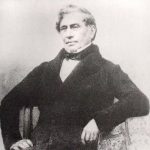 In the 1800s, women in medicine were nurses, and not well trained. They were often taught by a doctor, on the job. It was mostly because he needed help in his medical office. It was somehow decided that women just didn’t have the capability to be doctors, and the idea of a woman performing surgery was just beyond anyone’s comprehension. Be that as it may, women would soon become intent on finding a way to succeed in medicine with or without the help of men. Like it or not, the world was going to change, and women were going to spearhead some of that change.
In the 1800s, women in medicine were nurses, and not well trained. They were often taught by a doctor, on the job. It was mostly because he needed help in his medical office. It was somehow decided that women just didn’t have the capability to be doctors, and the idea of a woman performing surgery was just beyond anyone’s comprehension. Be that as it may, women would soon become intent on finding a way to succeed in medicine with or without the help of men. Like it or not, the world was going to change, and women were going to spearhead some of that change.
In 1865, a decorated surgeon named James Barry passed away from dysentery. That was not an unusual event in those days. Medical experts had not figured out exactly what to do for dysentery. Barry’s death was a sad thing for all those whose lives he had saved with his surgical skills. As often happened in those days, the family or the help was charged with preparing the body of the deceased for burial. When a housemaid began preparing Barry’s body for interment, she discovered a shocking secret. As it turned out, Dr Barry was not a man at all, she was a woman. Barry was born Margaret Ann Bulkley was born in Cork, Ireland, around 1789. The daughter of a grocer, Margaret grew up frustrated by the limits placed on her because of her gender. At just 18 years old, Margaret yelled at her brother, “Were I not a girl, I would be a soldier!” Of course, the idea of a woman, intelligent enough or not, going to medical school was forbidden. So, Margaret Bulkley, determined to become a surgeon, became James Barry. Even after graduating from medical school, she knew that she would have to continue the persona if she was going to have any patients.
In 1809, when Barry arrived at Edinburgh Medical School, one of the top medical schools in Europe, he wore a long overcoat and 3-inch shoe inserts. Fellow classmates remember Barry speaking in a high-pitched voice. Barry never took off his overcoat, even in summer, and stared down anyone who questioned his story. After graduation, he just continued the charade. For nearly 50 years, Dr. James Barry, disguised as a man, worked hard and became one of the top surgeons in the 19th century, but how did she manage to carry of such a deception for so many years? Someone must have known the truth. It’s hard to say if her desire to be a surgeon was just so strong that she would successfully carry out her plan, forsaking things like marriage and children, in favor of medicine, I’m sure that after a while, it just became easier to live as a man. The people of that era, obsessed with scandal speculated about Barry’s true identity and why the surgeon lied for decades. I’m sure all of the ladies had a great time with their afternoon tea parties.
When Dr. James Barry’s housemaid, Sophia Bishop discovered that Barry was biologically female, her screams could be heard all over the house. The undertakers were brought in and they quickly confirmed Barry’s secret. Like a flood, the news spread across the British Empire. Barry’s secret life raised a number of questions, starting with, how a nearly 5 foot tall woman was able to pass as a man for decades. Bulkley/Barry fooled everyone…for 50 long years. She was a surgeon ahead of her time. It’s just too bad that she couldn’t tell everyone that she, a woman, was a great surgeon too.

